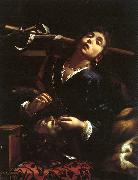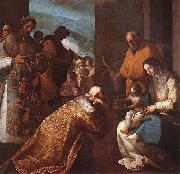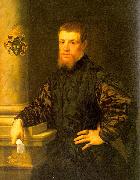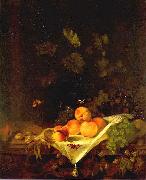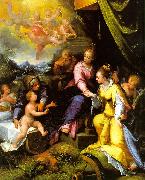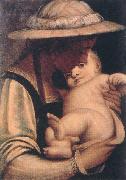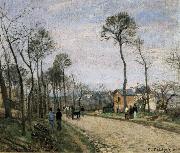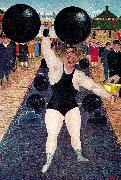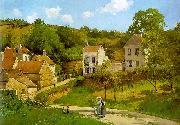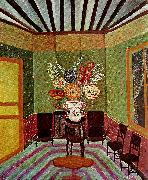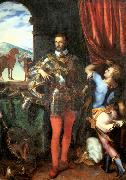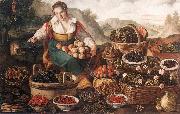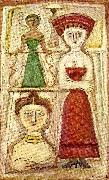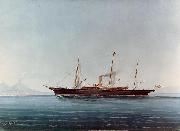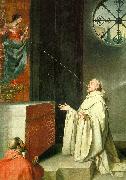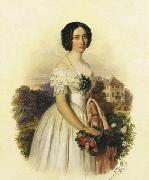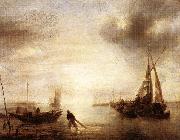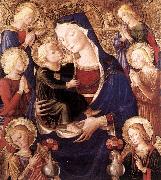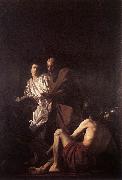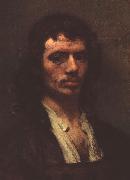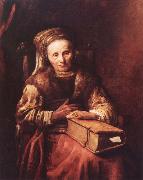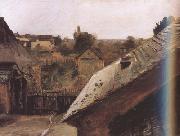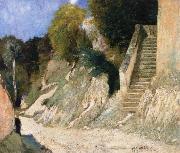|
|
|
|
|
|
|
|
|
|
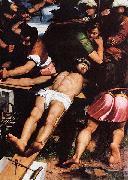 |
Callisto Piazza
|
|
(1500-1561) was an Italian painter.
Callisto, a member of the Piazza family of painters, was born in Lodi, Lombardy.
In 1523 he was working in Brescia. His first dated and signed work is from the following year, and shows a typical Brescian style. This style was then emerging, and included artists such as Romanino and Moretto. Piazza shows influences from contemporaries such as Dosso Dossi and Ludovico Mazzolino of the Ferrarese school, as well as Giovanni Agostino da Lodi.
In 1526-1529 Piazza worked in Val Camonica, at Erbanno, Borno, Breno, Esine and Cividate Camuno. In 1529 he returned to his native Lodi where he formed a workshop with his brothers Cesare and Scipione (died 1552). In 1538, while in Crema, he married the noblewoman Francesca Confalonieri. Later Callisto moved to Milan, where he received numerous commissions, such as the decoration of the San Girolamo chapel in Santa Maria Presso San Celso (1542); the decoration of the refectory of the convent of Sant'Ambrogio (1545); the frescoes for the Saletta Negra in the Castello Sforzesco; and the decoration of the Simonetta chapel in San Maurizio al Monastero Maggiore (1555), largely executed with the assistance of his son Fulvio. He also worked in Lodi at the Incoronata (1454), Novara, at the Abbey of Chiaravalle and other areas of Lombardy.
|
|
|
|
|
|
 |
CAMASSEI, Andrea
|
|
Italian painter, Roman school (b. 1602, Bevagna, d. 1649, Roma) |
|
|
|
|
|
|
|
 |
camille corot
|
|
Paris 1796-Paris 1875
Corot's students included Alfred Sisley, Camille Pissarro, Berthe Morisot, Stanislas Lepine, Adolphe Appian and Dagnan-Bouveret. |
|
|
|
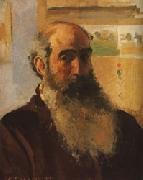 |
Camille Pissarro
|
|
Caribbean-born French Pointillist/Impressionist Painter, ca.1830-1903 |
|
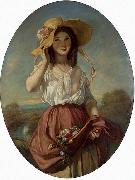 |
Camille Roqueplan
|
|
Camille Joseph Etienne Roqueplan, 18 February 1802 in Mallemort; † 30 September 1855 in Paris) was a French painter.
|
|
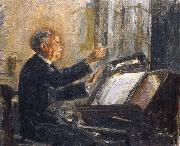 |
camille saint
|
|
Period: Post-Romantic (1870-1909)
Country: France
Born: October 09, 1835 in Paris, France
Died: December 16, 1921 in Algiers, Algeria
Genres: Chamber Music, Choral Music, Concerto, Keyboard Music, Miscellaneous Music, Opera, Orchestral Music, Symphony
|
|
|
|
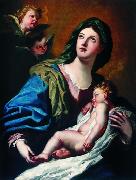 |
Camillo Procaccini
|
|
(1551 - August 21, 1629) was an Italian painter. He has been posthumously referred to as the Vasari of Lombardy, for his prolific Mannerist fresco decoration.
Born in Bologna, he was the son of the painter Ercole Procaccini the Elder, and older brother to Giulio Cesare and Carlo Antonio, both painters.
In 1587 he distinguished in the fresco decoration of the Basilica della Ghiara in Reggio Emilia. In the late 1580s he moved to Milan, where count Camillo Visconti Borromeo commissioned him the decoration of his villa in Lainate. The organ shutters for the Cathedral of Milan were painted after 1590 by Camillo, Giuseppe Meda (died 1599), and Ambrogio Figino. His other works of note include the frescoes of the nave and the apse of the Cathedral of Piacenza in collaboration with Ludovico Carracci (1605 - 1609), and the vault and choir in Santi Paolo e Barnaba of Milan. Also famous is a Nativity in the Sacro Monte d'Orta. Among his pupils is Carlo Biffi.
Among his many other works are a Martyrdom of St. Agnes painted in fresco in the sacristy of Milan cathedral; a Madonna and Child painted for the church of Santa Maria del Carmine; an 'Adoration of the Shepherds found in the Brera; and the ceiling of the church of Padri Zoccolanti, representing the Assumption of the Virgin. eall in the same city. He also painted a Last Judgment for the church of San Prospero at Reggio; He painted a St. Roch administering the Sacrament to the Plague-stricken.
|
|
|
|
|
|
|
|
|
|
|
|
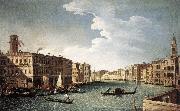 |
CANAL, Bernardo
|
|
Italian painter, Venetian school (b. 1664, Venezia, d. 1744, Venezia) |
|
 |
Canaletto
|
|
Italian Rococo Era Painter, 1697-1768 |
|
 |
Candido Lopez
|
|
(29 August 1840eDecember 31, 1902) was an Argentine painter and soldier. Born in Buenos Aires, he is considered one of Argentina's most important artists. He is most famous for his detailed paintings and drawings of battles of the War of the Triple Alliance, in which he also fought, losing his right arm. As a result, he learned to paint with his left hand.
He was already a prestigious artist by age seventeen, and had been taught by the exiled Italian Risorgimento artist Baldassare Verazzi. His paintings of battles reflect his love of detail and showy colors that depict the war in miniature. Many of his works are found in the National Fine Arts Museum in Buenos Aires. He is buried in La Recoleta Cemetery, also in Buenos Aires.
|
|
|
|
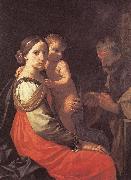 |
CANTARINI, Simone
|
|
Italian painter, Bolognese school (b. 1612, Pesaro, d. 1648, Pesaro) |
|
|
|
|
|
|
|
|
|
|
|
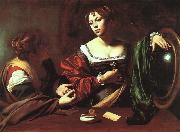 |
Caravaggio
|
|
Italian Baroque Era Painter, ca.1571-1610 |
|
|
|
|
|
 |
Carel de Moor
|
|
(February 25, 1655 - February 16, 1738) was a Dutch Golden Age etcher and painter. He was a pupil of Gerard Dou.
Carel de Moor was born in Leiden. According to Houbraken, his father was an art dealer who wanted him to study languages and only allowed him to study art when his talent for drawing surfaced at a young age. Houbraken met him in person at the atelier of Godfried Schalcken when he was completing his education there. According to the RKD he was the son of a Leiden painter of the same name and a pupil of Dou, Frans van Mieris, Godfried Schalcken, and Abraham van den Tempel. He became a member of the Leiden Guild of St. Luke in 1683, and became deacon many times over in the years 1688-1711. His own pupils later were Pieter Lyonet, Andrei Matveev, Arent Pijl, Arnout Rentinck, and Mattheus Verheyden.
|
|
|
|
|
|
 |
Carel Jacobus Behr
|
|
(9 July 1812 in The Hague - 11 November 1895) was a Dutch painter, watercolorist and draftsman. He was a pupil of Bartholomeus Johannes van Hove and mainly painted cityscapes, genre scenes and portraits.
In 1836 he produced, commissioned by The Hague municipal government, an image of the town hall there, which carried off the approval of connoisseurs. In 1837 he became a member of the Royal Academy in Amsterdam. His work is found in various collections and different exhibitions, like at the Hague in 1839, Rotterdam in 1840 and again at the Hague in 1841.
|
|
|
|
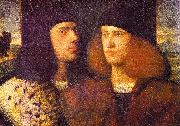 |
CARIANI
|
|
Italian Painter, ca.1490-1547 |
|
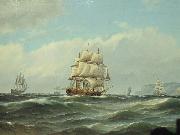 |
Carl Bille
|
|
painted Shipping off the Norwegian Coast in 1889 |
|
|
|
|
|
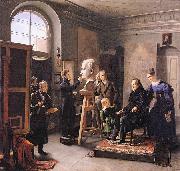 |
Carl Christian Vogel von Vogelstein
|
|
(26 June 1788, Wildenfels, Kursachsen - 4 March 1868, Munich), born Vogel, was a German painter.
Son of the child and portrait painter Christian Leberecht Vogel, Vogel was trained early in life by his father. From 1804 he visited the Kunstakademie in Dresden, where he copied many paintings in the Gemäldegalerie and also produced the first of his own portraits.
In 1807 he replied to an invitation from Baron von Löwenstern, whose children he had taught in Dresden, to come to Dorpat in Livland. In 1808 he moved to Saint Petersburg, where he set up a studio in the princely and successfully worked producing portraits of nobles and diplomats.
In 1812 Vogel was finally rich enough to make a long-desired grand tour to Italy, stopping off at Berlin and Dresden on the way, where he painted his parents and Franz Pettrich. From 1813 to 1820 he lived in Rome, where many German artists were active at that time. He tried to run a middle course between the classicising and romanticising schools then prevailing there, with a style of his own closely drawing on that of Raphael Mengs. In Italy he copied a large number of paintings and wall paintings by the old masters. On later journeys he further augmented his collection of copies and in 1860 published a catalogue of them.
Besides religious paintings, landscapes and anatomical studies, Vogel also produced portraits in Rome, of subjects such as Bertel Thorvaldsen, Lucien Bonaparte and - on behalf of the king of Saxony - Pope Pius VII. Vogel much enjoyed Rome, as Ringseis illustrates by this story - in 1818 he received a gift of a bottle of 1634 Rheinwein wine (given by crown prince Louis I of Bavaria in thanks for the decoration of a festal hall) by unanimous resolution of his colleagues
|
|
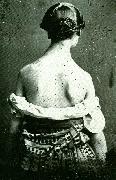 |
carl curman
|
|
född 8 mars 1833, död 1913, var en svensk vetenskapsman, läkare och professor, som även är känd för de många fotografier |
|
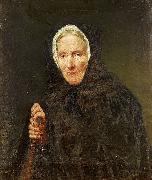 |
Carl d Unker
|
|
(3 February 1828 - 23 June 1866)was a Swedish artist. He was mostly known as a socially oriented genre painter whose works were contemporary subjects of his time, like waiting rooms at railway stations, and scenes from pawnshops for example.
D'Unkers father was a Norwegian military, his mother Swedish. He began his career as a military and had served at the Svea Life Guards for a short time, when he in 1848 volunteered in the First Schleswig War 1848-1849. Shortly after his return to Sweden he abandoned his military path and went to the arts. He moved to Desseldorf to study painting, there he got married to a wealthy Russian woman and could live a carefree life financially. He became a very popular artist on the continent. From 1861 he suffered from sickness in his right arm so he had to paint with his left arm. He made a brief visit to Sweden in 1865, and was appointed professor by Swedish king Charles XV. The following year he died. |
|
|
|
|
|
|







